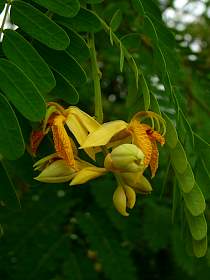Tamarind, Tamarindus indica
tree of the family Fabaceae - subfamily Caesalpinia
(see Caesalpinia also)
 Origin: Eastern Africa. Origin: Eastern Africa.
Habitat: in European climate, it grows only in greenhouses or cold veranda, because it does not support frost. Recommended position: Full light.
Height: 20 m in its original area, 2 m in culture in receptacle.
Shape: spread.
Deciduous foliage. Leaves paripinnate, composed of many small leaflets (up to 12 pairs), with a delicate green color. They have the ability to close at dusk. They are rounded at the tip as in Cesalpiniacees.
Flowers in June.
Fruits: big pods which resemble peanuts, known as Tamarind or dates of India.
Use: The fruits of the tamarind are used for to them curative properties, in syrup, and also in pasta of fruits and sorbets. The pulp of the fruit is rich in calcium and also contains many other elements such as the phosphorus.
The tamarind is very decorative and can also be cultivated as bonsai.
Literature:
Le grand tamarinier, Joëlle Escormier, Azalées editions, Sainte- Marie, on 2001. The history of a child in search of a serenity wich he finds in a tree.
|